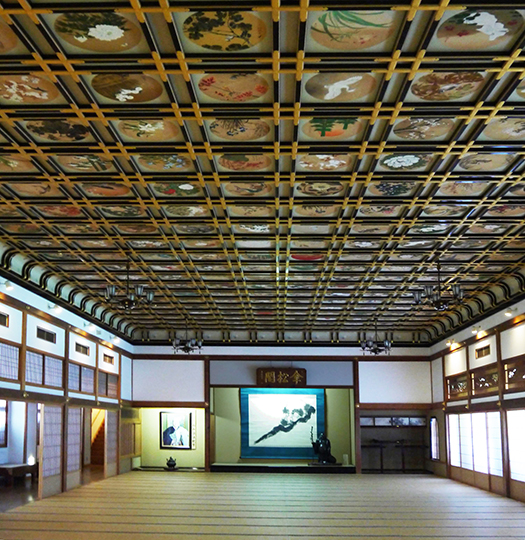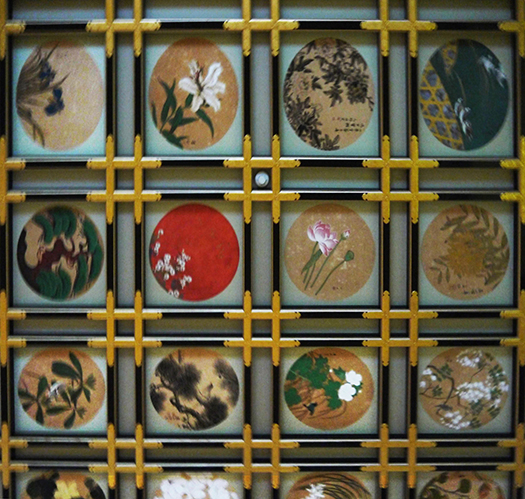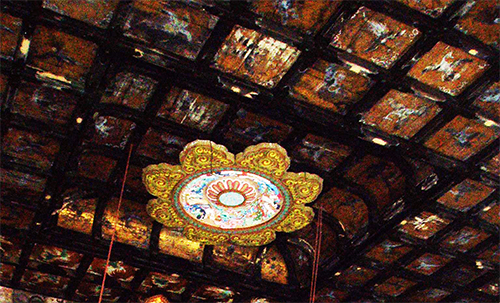


さて永平寺参観でいちばんはじめに見学できるのが「傘松閣」です。
広大な156畳敷きの大広間で天井に格子組が施されて額縁で区切られた部位に
それぞれ日本画の名品がビッシリと飾られているのです。
まるで西洋のステンドグラスのよう。傘松閣は昭和5年に創建されたもので、
道元の時代からのデザインコードのニオイはあまりしないけれど、
一方で3枚目の写真はほぼ同時代の鎌倉・建長寺仏殿の天井画で同様の格子画。
南北朝時代製作の本尊・地蔵菩薩の上に飾られているのですが
建物自体は江戸期のものとされている。
デザインコードとしての天井の格子組は飛鳥・奈良時代から見られるけれど、
写真の格天井は平安時代に国風文化なった。格子木の幅が細く格子間の四角が
とても大きいことが特徴で仏教寺院に広く用いられている。
その空隙の部分に絵を描くのは、建築工芸の中核的表現手法のように思える。
仏教寺院建築というものが、日本人の空間感受性の涵養について
非常に重要な役割を果たし続けてきたということが浮き彫りになると思います。
建築の基本は雨風・雪、寒冷の自然環境から人間を守る、ということでしょうが、
次いでは「空間を彩る」というごく自然な営為が発生するのでしょう。
ネアンデルタールの人々が洞窟壁面に絵画を描いたのは、
空間を彩るということが始原の動機だったに違いない。
人類は日中に多くの体験を自然から受容する。そのイメージのなかから
先端的な印象が脳裏に残像として記憶されて洞窟のようなやすらぎの空間に
その情念を描き上げた、というのが初動動機だったと思う。
肉食の対象である動物への強烈な印象をそのまま岩のキャンパスに叩き付けた。
おなじ人間感情として共感力の高いこうした残像からは
なにごとか、人間にやすらぎとか満足感のようなものを印象させた。
この永平寺の最初の空間で訪れた人々は空間の広がりに開放感を感じ、
そして柱のない広間が天井画で満たされている様を体験する。
たぶん宗教空間というのは人間のこころの領域に対して
すべての建築的営為を集中動員して語りかけていくというのが目的。
昭和5年当時の著名な画家144名による天井絵が描かれている。
日本画の大家で永平寺光明蔵正面の大壁画を描いた小室翠雲らの尽力により
荒木十畝、伊東深水、川合玉堂、鴨下晁湖、野田九浦、島田墨仙、益田玉城、
水上泰生、山田敬中、山本昇雲など計144名の日本画家によって描かれたもの。
やはり日本の精神性空間には日本画の表現力がしっくりと似合う。
一点一点、日本画としてじっくり眺めていたくなる・・・。
English version
[Spatial beauty of Japanese painting “lattice ceiling framed” Eiheiji-5]
By the way, the first place you can visit when visiting Eiheiji Temple is “Kasamatsukaku”.
In the vast 156 tatami mat room, the ceiling is latticed, and the part separated by the frame is
Each of them is decorated with masterpieces of Japanese painting.
It’s like Western stained glass. This Kasamatsukaku was built in 1945, so
I don’t really smell the design code from the Dogen era,
On the other hand, the third photo is a ceiling painting of the Buddha Hall in Kenchoji, Kamakura, which is about the same period, and is a similar lattice painting.
It is displayed on the Jizo Bodhisattva, the principal image of the Northern and Southern Dynasties.
The building itself is said to be from the Edo period.
The ceiling grid as a design code has been seen since the Asuka / Nara period,
The ceiling like the one in the picture became a national culture during the Heian period. The width of the lattice tree is narrow and the squares between the lattices are
It is very large and is widely used in Buddhist temples.
Drawing a picture in the void seems to be the core expression method of architectural crafts.
Buddhist temple architecture is about the cultivation of Japanese space sensitivity
I think it will become clear that it has continued to play a very important role.
The basis of architecture is to protect humans from the natural environment such as rain, wind, snow, and cold.
Next, a very natural act of “coloring the space” will occur.
The Neanderthals painted on the walls of the cave
Coloring the space must have been the original motive.
Mankind accepts many experiences from nature during the day. From that image
A cutting-edge impression is memorized as an afterimage in my mind, creating a relaxing space like a cave.
I think the first motive was to draw up that passion.
The strong impression of the animals that are the target of carnivorousness was struck on the rock campus as it was.
From such an afterimage that has high empathy as the same human emotion
Something impressed human beings with something like peace and satisfaction.
People who visited in the first space of Eiheiji felt a sense of openness in the expanse of the space.
Then, experience how the hall without pillars is filled with ceiling paintings.
Maybe the religious space is for the realm of the human mind
The purpose is to concentrate and talk to all architectural activities.
Ceiling paintings by 144 famous painters at the time of Showa 5 are drawn.
Thanks to the efforts of Komuro Suiun and others who painted the large mural painting in front of Mitsuakizo Eiheiji, a master of Japanese painting.
Araki Jippo, Ito Shinsui, Kawai Gyokudo, Kamoshita Akirako, Noda Kyuho, Shimada Bokusen, Masuda Gyokujo,
It was drawn by a total of 144 Japanese painters such as Taisei Mizukami, Keichu Yamada, and Shoun Yamamoto.
After all, the expressive power of Japanese painting suits the spiritual space of Japan.
I want to take a closer look at each one as a Japanese painting.
Posted on 12月 2nd, 2021 by 三木 奎吾
Filed under: 住宅マーケティング, 日本社会・文化研究








コメントを投稿
「※誹謗中傷や、悪意のある書き込み、営利目的などのコメントを防ぐために、投稿された全てのコメントは一時的に保留されますのでご了承ください。」
You must be logged in to post a comment.